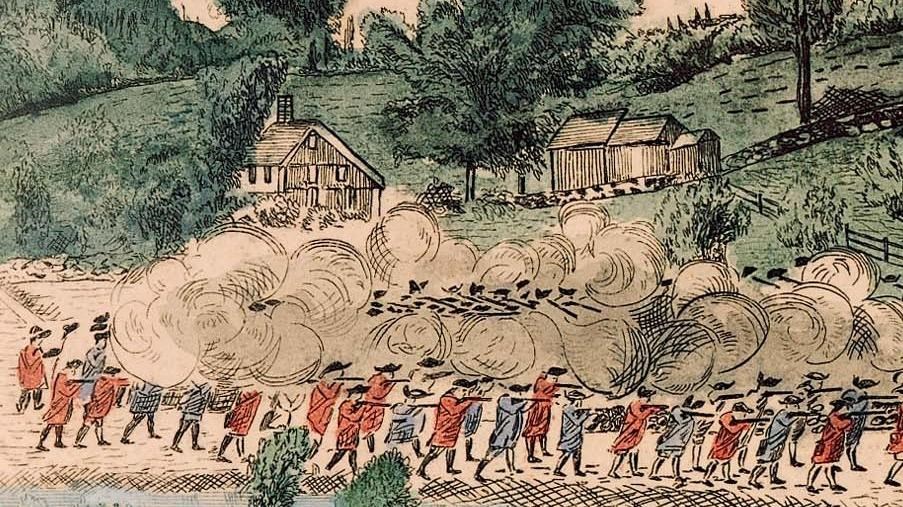Last updated: January 18, 2023
Place
The Captain David Brown House Site

Amos Doolittle
Accessible Sites, Historical/Interpretive Information/Exhibits, Pets Allowed, Scenic View/Photo Spot, Trailhead, Wheelchair Accessible
Family ownership
The Brown family of Concord were among the earliest English occupants of the land along the banks of the Concord River. For thousands of year prior to that the land, rich in fertile soils near the river and fishing, was home to an Indigenous settlement. In 1644, just 9 years after the English town of Concord was founded, Thomas Brown, David Brown’s great grandfather, purchased the homestead from Reverend Peter Bulkeley.
The purchase included “the house…on the west side of the Great River together with four acres of ground which it stands on” plus ten acres of meadow. Shortly after this, the town laid out a road from the center village, north along what is now Monument Street, then west across the river via a bridge.The road continued west from the bridge along a causeway beside the river. It then branched east and west. The west branch ran close by the Brown homestead.
David Brown, born in 1732, inherited the property in 1750 after the death of his father. Sometime between 1752 and 1768 he tore down the old house and built a new one, “49 ft southwest of where the old house stood.” It was nicely situated just under the crest of the hill and beside the gently-flowing Concord River. In 1756 David married Abigail Munro. By 1776 the couple had ten children: Purchase (b. 1757); Sarah (b. 1761); Abigail (b. 1762); David (b. 1764); Ephraim (b. 1765); Elizabeth (b. 1767); William (b. 1768); Thomas (b. 1771); Reuben (Reuben, b. 1773); Joseph (b. 1776).
Appearance
Not much is known about the appearance of the house David, Abigail and their family lived in. Middlesex County records indicate it was a two-story house with four rooms and a cellar. The homestead also contained two adjoined barns that were close to the road. In the mid-19th century, Concord resident John Shepard Keyes wrote that David and Abigail “seemed to have lived happily together for many years in the old red house on the bank of the river, near the battleground…” The house also appears in the famous engraving of the North Bridge fight by Amos Doolittle. However, as far as history can tell, it was a modest four-room house that was, at some point, painted red.
April 19, 1775
In early 1775 David Brown, who had already been active in Concord’s response to the Revolutionary crisis, was elected to command one of the town’s newly formed minute man companies and was commissioned as a captain. On April 19, 1775 Captain Brown and his company were formed up with several other companies from Concord and surrounding towns in a field on high ground overlooking Concord’s Bridge. The place where they formed, now known as the Muster Field, was a piece of pastureland owned by Captain Brown himself. From there he could see his home. His oldest son, Purchase, was serving as a minute man that day in his father’s company.
Prior to the battle, British soldiers were posted near the Brown family house as they guarded the west branch of the Groton Road which led to the farm of Colonel James Barrett. There is strong evidence that the house was entered by British soldiers. Brown family tradition states that a mirror belonging to the family was smashed by the soldiers. It resides today at Concord Museum. In the Doolittle engraving, the house stands just yards from the road and the colonial firing line during the fight.
During and After the Revolution
During the war Captain Brown remained active in the town though his military service was largely confined to his experiences on April 19, 1775. After the Revolution David Brown represented Concord in the Massachusetts Great and General Court and held many other town offices.In 1793 the old Groton road which crossed North Bridge and ran along the river close by David and Abigail’s home, was abandoned. The new road crossed the river further north. Another road, today known as Liberty St., turned west just beyond the new bridge then curved southwest running behind the Brown home.
David Brown died of a fever in 1802 at age 72. The house then passed to his youngest son, Joseph. Joseph died in 1821. By that time the house had become run down. It was sold in 1822 to provide for Abigail’s support. In 1865 the property was sold to John Shepard Keyes who had it torn down. He then sold the land to Edwin Barrett who built a large mansion near the site. And so the “old red house on the bank of the river” where David and Abigail lived happily for so many years, and stood witness to the events of April 19, 1775, was lost forever.
Sources
Captain David Brown Letters, 1792-1800 | Special Collections | Concord Free Public Library (concordlibrary.org)
Dietrich-Smith, D. (2004). Cultural Landscape Report: North Bridge Unit, Minute Man National Historical Park. National Park Service. Brookline MA: Olmsted Center for Landscape Preservation.
Donahue, Brian, “The Great Meadow: Farmers and the Land in Colonial Concord” Yale University Press, New Haven CT, 2004
Keyes, J.S. “The Centennial of the Social Circle in Concord: March 21, 1882”
Synenki, Alan T., Pendery Steven, Sideris, Lou, “Traces of the Past: A Guide to Minute Man National Historical Park as Told Through the Archeological Story” Eastern National, Concord MA 2002
Torres-Reyes, Ricardo, “Captain Brown’s House: Historic Data, Minute Man National Historical Park” 1969 Division of History, Office of Archeology and Historic Preservation, USDoI, NPS
